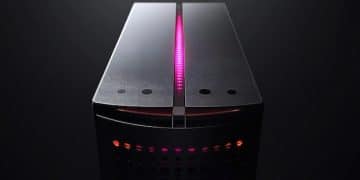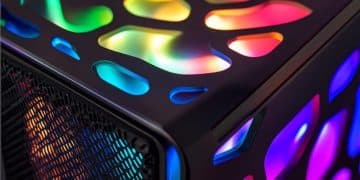Unlock PC Gaming Potential: Advanced Overclocking Techniques for US Gamers
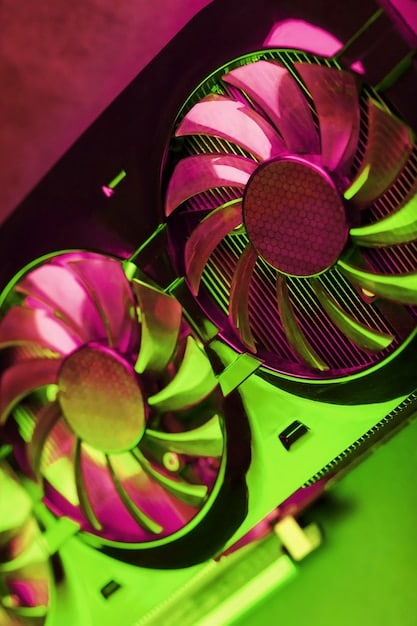
Unlocking Hidden Potential: Advanced Overclocking Techniques for PC Gamers in the US involves optimizing your system’s components to run faster than their stock settings, boosting performance for a smoother gaming experience and higher frame rates.
Ready to take your PC gaming performance to the next level? Unlocking Hidden Potential: Advanced Overclocking Techniques for PC Gamers in the US is a deep dive into squeezing every last bit of performance out of your hardware, offering a competitive edge and a visually stunning gaming experience.
Understanding Overclocking: The Basics for US Gamers
Overclocking, at its core, is the process of making your computer components run faster than their original factory settings. This can lead to significant performance gains, especially in gaming, allowing for higher frame rates and smoother gameplay. However, it’s essential to understand the basics before diving into advanced techniques.
What is Overclocking and Why Do It?
Overclocking involves increasing the clock rate of components like your CPU and GPU. This effectively makes them perform more calculations per second, resulting in faster processing and rendering times. Gamers often overclock to achieve higher frame rates, reduce lag, and improve overall gaming experience.
Potential Risks and How to Mitigate Them
While overclocking can be rewarding, it’s not without risks. Pushing your components too hard can lead to overheating, instability, and even permanent damage. Mitigation strategies include using adequate cooling solutions (like liquid coolers), monitoring temperatures closely, and gradually increasing clock speeds. Always prioritize stability over extreme performance gains.
- Cooling Solutions: Investing in a good CPU cooler or liquid cooling system is crucial for dissipating heat.
- Temperature Monitoring: Use monitoring software to keep an eye on CPU and GPU temperatures.
- Gradual Increases: Increase clock speeds in small increments and test stability after each change.
- Stress Testing: Use benchmark and stress test software to ensure your system remains stable under load.
Understanding the basics and potential risks is paramount for a successful overclocking journey. By taking a measured approach and implementing proper cooling and monitoring, US gamers can safely unlock hidden performance in their systems.
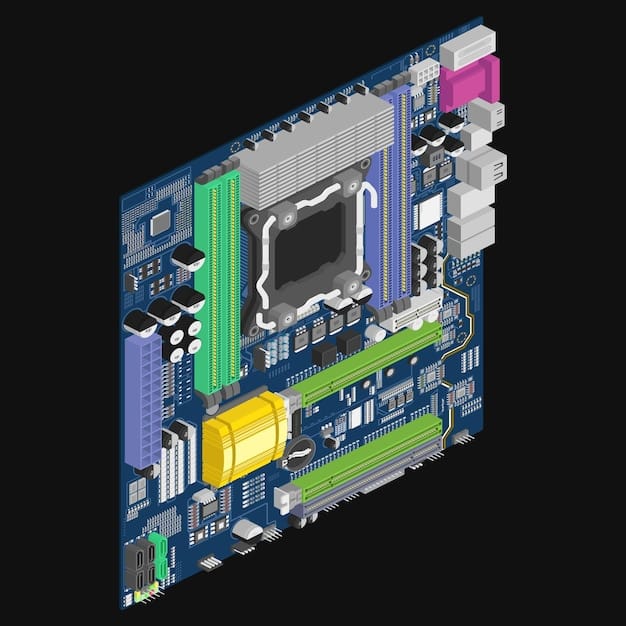
Essential Hardware for Overclocking in the US
Not all hardware is created equal when it comes to overclocking. Certain components are more amenable to being pushed beyond their factory settings, while others may act as bottlenecks. Choosing the right hardware is a critical first step in unlocking hidden potential through advanced overclocking techniques for PC gamers in the US.
CPU and Motherboard Selection
When selecting a CPU for overclocking, look for models with unlocked multipliers (often indicated by a “K” in Intel CPUs or “X” in AMD CPUs). The motherboard should have a robust VRM (Voltage Regulator Module) to provide stable power delivery to the CPU. Chipsets like Intel’s Z-series or AMD’s X-series are generally recommended for overclocking.
RAM Considerations
RAM speed and latency also play a significant role in overclocking. Faster RAM can directly impact gaming performance, especially in CPU-bound scenarios. Look for RAM kits with high clock speeds and low timings. Ensure your motherboard supports XMP (Extreme Memory Profile) for easy configuration of RAM settings.
Power Supply Unit (PSU)
Overclocking increases the power draw of your components, so a reliable and adequately sized PSU is a must. Choose a PSU with enough wattage to handle your overclocked CPU and GPU, plus some headroom for safety. Look for 80+ Gold or Platinum certified PSUs for efficiency and stability.
- Unlocked CPUs: Intel “K” series or AMD “X” series CPUs are designed for overclocking.
- Robust VRM: Motherboards with strong VRMs ensure stable power delivery.
- Fast RAM: High clock speed and low latency RAM improve performance.
- Adequate PSU: Choose a PSU with enough wattage and 80+ certification.
Selecting the right hardware is a cornerstone of successful overclocking. By paying attention to CPU, motherboard, RAM, and PSU choices, US gamers can build a solid foundation for pushing their systems to the limit.
Overclocking Software and Monitoring Tools for US Gamers
Overclocking isn’t just about hardware; the right software and monitoring tools are also essential. These tools allow you to adjust clock speeds, monitor temperatures, and stress-test your system for stability. Let’s explore some of the most popular and effective options available to US gamers.
CPU Overclocking Utilities
Intel Extreme Tuning Utility (XTU) and AMD Ryzen Master are popular software options specifically designed for overclocking Intel and AMD CPUs, respectively. These tools offer user-friendly interfaces for adjusting clock speeds, voltages, and other settings. They also provide real-time monitoring of temperatures and voltages.
GPU Overclocking Utilities
MSI Afterburner is a widely used GPU overclocking utility that works with both NVIDIA and AMD graphics cards. It allows you to adjust GPU clock speeds, memory clocks, and fan speeds. Afterburner also provides detailed monitoring of GPU temperatures, usage, and voltages. EVGA Precision X1 is another excellent option, particularly for EVGA graphics cards.
System Monitoring Tools
HWMonitor is a comprehensive system monitoring tool that displays real-time temperatures, voltages, and fan speeds for various components, including CPU, GPU, motherboard, and storage devices. It’s an invaluable tool for keeping an eye on your system’s health during overclocking. Additionally, tools like AIDA64 offer detailed system information and benchmarking capabilities.
- Intel XTU/AMD Ryzen Master: User-friendly tools for CPU overclocking and monitoring.
- MSI Afterburner/EVGA Precision X1: Versatile GPU overclocking and monitoring utilities.
- HWMonitor: Comprehensive system monitoring for temperatures and voltages.
Having the right software and monitoring tools is crucial for effective and safe overclocking. These tools empower US gamers to fine-tune their systems, monitor performance, and ensure stability while pushing their hardware to the limit.
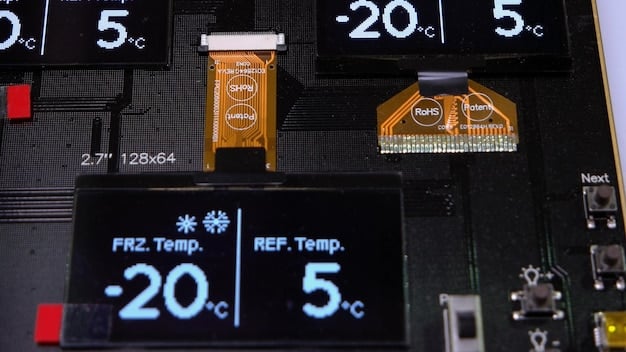
Advanced CPU Overclocking Techniques for US Gamers
Once you have a grasp of the basics, you can delve into more advanced CPU overclocking techniques. These involve fine-tuning various settings to achieve optimal performance and stability. However, they also require a higher level of understanding and caution.
Voltage Tuning
Adjusting the CPU voltage is a critical aspect of advanced overclocking. Increasing the voltage can stabilize higher clock speeds, but it also increases heat output. It’s essential to find the lowest voltage that allows for stable operation at your desired clock speed, a process known as voltage tuning. Start with small voltage increments and monitor temperatures closely.
Load Line Calibration (LLC)
Load Line Calibration (LLC) is a motherboard setting that compensates for voltage droop under load. Voltage droop occurs when the CPU voltage decreases as the CPU draws more power. Setting the LLC too high can lead to voltage overshoot, which can damage the CPU. Experiment with different LLC settings to find the optimal balance between stability and voltage accuracy.
BCLK Overclocking
Base Clock (BCLK) overclocking involves increasing the base clock frequency of the motherboard, which affects the clock speeds of the CPU, RAM, and other components. BCLK overclocking can provide additional performance gains, but it can also introduce instability. It requires careful adjustment and testing.
Advanced CPU overclocking techniques require a deep understanding of voltage tuning, LLC, and BCLK overclocking. By carefully adjusting these settings and monitoring your system, US gamers can squeeze even more performance out of their CPUs.
Advanced GPU Overclocking Techniques for US Gamers
GPU overclocking is another avenue for boosting gaming performance. Just like with CPUs, advanced GPU overclocking involves fine-tuning various settings to achieve optimal results. Let’s explore some advanced techniques for extracting maximum performance from your GPU.
Memory Overclocking
Overclocking the GPU memory can significantly improve performance in memory-intensive games and applications. Increase the memory clock speed gradually and test for stability. Look for artifacts or crashes, which indicate that the memory is overclocked too high. Some GPUs respond better to memory overclocking than others, so experiment to find the sweet spot.
Power Limit Adjustment
Increasing the power limit allows the GPU to draw more power, which can help stabilize higher clock speeds. However, it also increases heat output. Monitor GPU temperatures closely and ensure your cooling solution can handle the increased heat load. Start with small power limit increments and test for stability.
Custom Fan Curves
Creating custom fan curves can help maintain optimal GPU temperatures during overclocking. Set aggressive fan speeds at higher temperatures to prevent thermal throttling. Monitoring software like MSI Afterburner allows you to create and customize fan curves based on GPU temperature.
- Memory Overclocking: Improves performance in memory-intensive applications.
- Power Limit Adjustment: Allows the GPU to draw more power for stability.
- Custom Fan Curves: Maintains optimal GPU temperatures during overclocking.
Advanced GPU overclocking techniques can significantly boost gaming performance. By carefully adjusting memory clocks, power limits, and fan curves, US gamers can unlock hidden potential in their graphics cards.
Stress Testing and Stability: The Keys to Successful Overclocking in the US
Overclocking is not complete without thorough stress testing and stability verification. A system that appears stable during normal use might crash under heavy load, leading to frustration and potential data loss. Therefore, it’s crucial to put your overclocked system through its paces to ensure it can handle demanding tasks.
CPU Stress Testing
Prime95 is a popular CPU stress testing tool that pushes the CPU to its limits. It’s an excellent way to test the stability of your CPU overclock. Run Prime95 for several hours and monitor CPU temperatures. If your system crashes or produces errors, reduce your overclock or increase CPU voltage.
GPU Stress Testing
FurMark is a widely used GPU stress testing tool that simulates heavy GPU workloads. It’s an effective way to test the stability of your GPU overclock. Run FurMark for several hours and monitor GPU temperatures. If your system crashes or displays artifacts, reduce your overclock or increase GPU voltage.
RAM Stability Testing
Memtest86 is a standalone memory testing tool that can identify RAM errors. It’s essential to run Memtest86 after overclocking your RAM to ensure it’s stable. Run Memtest86 overnight and check for errors. If errors are present, reduce your RAM overclock or loosen your RAM timings.
Stress testing and stability verification are crucial steps in the overclocking process. By using tools like Prime95, FurMark, and Memtest86, US gamers can ensure their overclocked systems are stable and reliable.
| Key Point | Brief Description |
|---|---|
| 🌡️ Temperature Monitoring | Keep an eye on CPU/GPU temps to avoid overheating during overclocking. |
| ⚡ Voltage Tuning | Adjust CPU/GPU voltage for stable higher clock speeds. Use small increments. |
| ⚙️ Stress Testing | Use Prime95/FurMark to ensure system stability under heavy loads. |
| ❄️ Cooling Solutions | Invest in adequate cooling (air or liquid) to dissipate heat effectively. |
FAQ
▼
Overclocking is the process of running computer components, like CPUs and GPUs, at higher clock speeds than their factory settings, boosting performance.
▼
Risks include overheating, instability, and potential hardware damage if not done correctly. Proper cooling and monitoring can mitigate these risks.
▼
CPUs with unlocked multipliers (Intel “K” or AMD “X”), motherboards with robust VRMs, and fast RAM are ideal for overclocking.
▼
Tools like Intel XTU, AMD Ryzen Master, MSI Afterburner, and HWMonitor are essential for overclocking and monitoring system performance.
▼
Use stress testing tools like Prime95 and FurMark to push your system to its limits and monitor for crashes or errors. Adjust settings as needed.
Conclusion
Unlocking Hidden Potential: Advanced Overclocking Techniques for PC Gamers in the US can significantly improve gaming performance, but it requires careful planning, execution, and monitoring. By understanding the basics, choosing the right hardware, and using the appropriate software tools, US gamers can safely and effectively overclock their systems for a competitive edge.

